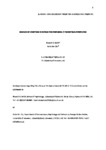Sources of variation in search and foraging: A theoretical perspective
| dc.contributor.author | Smith, Alastair | |
| dc.contributor.author | De Lillo, C | |
| dc.date.accessioned | 2021-06-28T16:31:44Z | |
| dc.date.issued | 2021-10-05 | |
| dc.identifier.issn | 1747-0218 | |
| dc.identifier.issn | 1747-0226 | |
| dc.identifier.other | ARTN 17470218211050314 | |
| dc.identifier.uri | http://hdl.handle.net/10026.1/17283 | |
| dc.description.abstract |
<jats:p> Search—the problem of exploring a space of alternatives to identify target goals—is a fundamental behaviour for many species. Although its foundation lies in foraging, most studies of human search behaviour have been directed towards understanding the attentional mechanisms that underlie the efficient visual exploration of two-dimensional (2D) scenes. With this review, we aim to characterise how search behaviour can be explained across a wide range of contexts, environments, spatial scales, and populations, both typical and atypical. We first consider the generality of search processes across psychological domains. We then review studies of interspecies differences in search. Finally, we explore in detail the individual and contextual variables that affect visual search and related behaviours in established experimental psychology paradigms. Despite the heterogeneity of the findings discussed, we identify that variations in control processes, along with the ability to regulate behaviour as a function of the structure of search space and the sampling processes adopted, to be central to explanations of variations in search behaviour. We propose a tentative theoretical model aimed at integrating these notions and close by exploring questions that remain unaddressed. </jats:p> | |
| dc.format.extent | 197-231 | |
| dc.format.medium | Print-Electronic | |
| dc.language | en | |
| dc.language.iso | en | |
| dc.publisher | SAGE Publications | |
| dc.subject | Foraging | |
| dc.subject | visual search | |
| dc.subject | memory | |
| dc.subject | cognitive control | |
| dc.subject | comparative cognition | |
| dc.subject | cognitive deficits | |
| dc.title | Sources of variation in search and foraging: A theoretical perspective | |
| dc.type | journal-article | |
| dc.type | Journal Article | |
| dc.type | Review | |
| plymouth.author-url | https://www.webofscience.com/api/gateway?GWVersion=2&SrcApp=PARTNER_APP&SrcAuth=LinksAMR&KeyUT=WOS:000710662700001&DestLinkType=FullRecord&DestApp=ALL_WOS&UsrCustomerID=11bb513d99f797142bcfeffcc58ea008 | |
| plymouth.issue | 2 | |
| plymouth.volume | 75 | |
| plymouth.publication-status | Published | |
| plymouth.journal | Quarterly Journal of Experimental Psychology | |
| dc.identifier.doi | 10.1177/17470218211050314 | |
| plymouth.organisational-group | /Plymouth | |
| plymouth.organisational-group | /Plymouth/Faculty of Health | |
| plymouth.organisational-group | /Plymouth/REF 2021 Researchers by UoA | |
| plymouth.organisational-group | /Plymouth/REF 2021 Researchers by UoA/UoA04 Psychology, Psychiatry and Neuroscience | |
| plymouth.organisational-group | /Plymouth/Users by role | |
| plymouth.organisational-group | /Plymouth/Users by role/Academics | |
| plymouth.organisational-group | /Plymouth/Users by role/Researchers in ResearchFish submission | |
| dc.publisher.place | England | |
| dcterms.dateAccepted | 2021-06-02 | |
| dc.rights.embargodate | 2021-10-8 | |
| dc.identifier.eissn | 1747-0226 | |
| dc.rights.embargoperiod | Not known | |
| rioxxterms.versionofrecord | 10.1177/17470218211050314 | |
| rioxxterms.licenseref.uri | http://www.rioxx.net/licenses/all-rights-reserved | |
| rioxxterms.licenseref.startdate | 2021-10-05 | |
| rioxxterms.type | Journal Article/Review |


